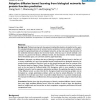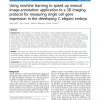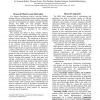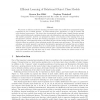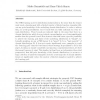1047 search results - page 121 / 210 » Learning the required number of agents for complex tasks |
BMCBI
2008
13 years 8 months ago
2008
Background: Machine-learning tools have gained considerable attention during the last few years for analyzing biological networks for protein function prediction. Kernel methods a...
BMCBI
2010
13 years 8 months ago
2010
Background: Image analysis is an essential component in many biological experiments that study gene expression, cell cycle progression, and protein localization. A protocol for tr...
AAAI
2000
13 years 9 months ago
2000
or cone, abstraction is chosen to represent a spectrum of user inputs/requirements that are narrowed, refined, and structured into a system design. User inputs require refinement f...
ICCV
2005
IEEE
14 years 9 months ago
2005
IEEE
We present an efficient method for learning part-based object class models from unsegmented images represented as sets of salient features. A model includes parts' appearance...
TCS
2011
13 years 2 months ago
2011
The PAC-learning model is distribution-independent in the sense that the learner must reach a learning goal with a limited number of labeled random examples without any prior know...
